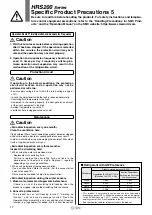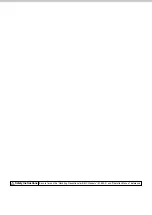
Warning
Grounding should never be connected to a water line,
gas line or lightning rod.
Caution
1. Power supply and communication cables should be
prepared by user.
2. Provide a stable power supply which is not affected
by surge or distortion.
If the voltage increase ratio (dV/dt) at the zero cross should
exceed 40 V/200
m
sec., it may result in malfunction.
3. This product is installed with a breaker with the
following operating characteristics.
For the user’s equipment (inlet side), use a breaker whose
operating time is equal to or longer than the breaker of this
product. If a breaker with shorter operating time is connected,
the user’s equipment could be cut off due to the inrush current
of the motor of this product.
dV
dV
dt
dt
= Voltage increase ratio
Time
Voltage
4 h
2 h
1 h
30 min
20 min
14 min
10 min
6 min
4 min
2 min
1 min
30 s
20 s
10 s
5 s
2 s
1 s
0.5 s
0.2 s
0.1 s
0.05 s
0.02 s
0.01 s
100
135
200
300
400 500 600 700
1000
1500 2000
3000 4000
Current (% for chiller main breaker volume)
Operating time
Min.
Max.
Electrical Wiring
Be sure to read this before handling the products. For safety instructions and tempera-
ture control equipment precautions, refer to the “Handling Precautions for SMC Prod-
ucts” and the “Operation Manual” on the SMC website: https://www.smcworld.com
HRS200
Series
Specific Product Precautions 4
Circulating Fluid
Caution
1. Avoid oil or other foreign matter entering the
circulating fluid.
2. When water is used as a circulating fluid, use tap
water that conforms to the appropriate water quality
standards.
Use tap water that conforms to the standards shown below (includ-
ing water used for dilution of ethylene glycol aqueous solution).
Tap Water (as Circulating Fluid) Quality Standards
The Japan Refrigeration and Air Conditioning Industry Association
JRA GL-02-1994 “Cooling water system – Circulation type – Make-up water”
Item
Unit
Standard value
Influence
Corrosion Scale
generation
Standard item
pH (at 25
°
C)
—
6.0 to 8.0
v
v
Electric conductivity (25
°
C) [
m
S/cm]
100
*
1
to 300
*
1
v
v
Chloride ion (Cl
–
)
[mg/L]
50 or less
v
Sulfuric acid ion (SO
4
2–
)
[mg/L]
50 or less
v
Acid consumption amount (at pH4.8)
[mg/L]
50 or less
v
Total hardness
[mg/L]
70 or less
v
Calcium hardness (CaCO
3
) [mg/L]
50 or less
v
Ionic state silica (SiO
2
)
[mg/L]
30 or less
v
Ref
erence item
Iron (Fe)
[mg/L]
0.3 or less
v
v
Copper (Cu)
[mg/L]
0.1 or less
v
Sulfide ion (S
2
–
)
[mg/L] Should not be detected.
v
Ammonium ion (NH
4
+
)
[mg/L]
0.1 or less
v
Residual chlorine (Cl)
[mg/L]
0.3 or less
v
Free carbon (CO
2
)
[mg/L]
4.0 or less
v
*
1 In the case of [M
Ω
·cm], it will be 0.003 to 0.01.
v
: Factors that have an effect on corrosion or scale generation.
Even if the water quality standards are met, complete prevention of corrosion
is not guaranteed.
3. Use an ethylene glycol aqueous solution that does
not contain additives such as preservatives.
4. Refer to "Operation at low ambient temperature or low
circulating fluid temperature" (page 14) for the con-
centration of the ethylene glycol aqueous solution.
5. When deionized water is used, the electric conductivity
should be 1
m
S/cm or higher (Electric resistivity: 1
M
Ω
·cm or lower).
Operation
Warning
1. Confirmation before operation
1) The fluid level of a tank should be within the specified range of “HIGH” and “LOW.”
When exceeding the specified level, the circulating fluid will overflow.
2) Remove the air.
Conduct a trial operation, looking at the fluid level.
Since the fluid level will go down when the air is removed
from the user’s piping system, supply water once again
when the fluid level is reduced. When there is no reduction
in the fluid level, the job of removing the air is completed.
Pump can be operated independently.
2. Confirmation during operation
Check the circulating fluid temperature.
The operating temperature range of the circulating fluid is be-
tween 5 and 35
°
C.
When the amount of heat generated from the user’s equipment is
greater than the product’s capability, the circulating fluid tempera-
ture may exceed this range. Use caution regarding this matter.
3. Emergency stop method
When an abnormality is confirmed, stop the machine immedi-
ately. After the machine has stopped, make sure to turn off the
breaker of the user’s equipment (on the upstream side).
16

















